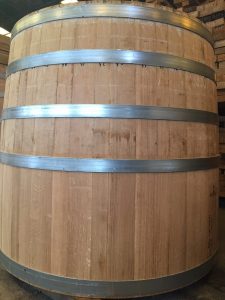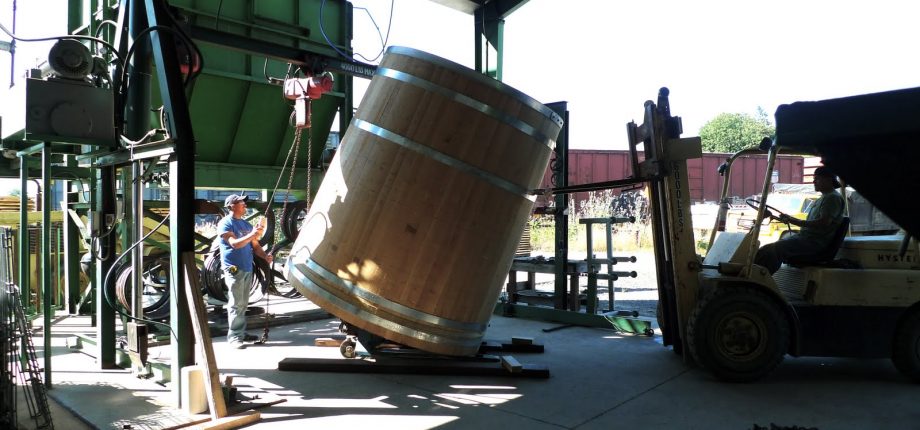By: Tyler Armour
This Fall, for the first time, Fielding Hills Winery will be utilizing an upright conical oak tank for fermenting and aging a portion of red wine.

Selected oak staves for our 30hL tank
This 30hL (hectoliter – see definitions below) or 793-gallon oak tank is currently being constructed in Cognac, France. Throughout the construction, the cooperage has been taking pictures of the process, so we are able to give you a behind-the-scenes look at what it takes to build an oak tank.
About 36 months before the tank construction begins, oak trees are harvested from designated forests across France. These trees are then sent to the cooperage where they are milled into staves and left to air-dry for 36 months outside in the elements. This air-drying process allows harsh wood tannins to naturally leach from the wood, resulting in less wood tannin transfer to the finished wine. After this aging process, the staves are brought back into the cooperage to be planed and sanded in preparation for assembly.

36 month air-dried staves are planed and sanded in preparation for tank assembly
To begin the tank assembly, or raising the tank, staves are laid out on a flat surface in the order in which they will be assembled. This step allows the cooper to pick-and-choose appropriately sized staves to achieve the desired tank circumference that results in a final tank volume of 30hL. Once stave layout is determined, assembly begins. Staves are stood up vertically and the conical design of the tank beings to take shape. Five metal hoops are positioned around the outside of the tank, at various heights, to ensure the staves are joined tightly.
Once the hoops are tightened, the tank undergoes a nearly day-long internal toasting process (at this point there is no top or bottom to the tank, just the side stave walls). This toasting process not only helps to permanently bend the staves to their final shape but also seasons the oak in a way that will add depth and complexity to wines fermented and aged within.

Internal tank assembly before metal hoops are tightened to solidify tank structure

Assembled tank after tightening hoops and toasting interior
After the toasting and final tightening of the hoops and staves is complete, a very counter-intuitive step is taken; the tank is taken back apart. Once again the staves are laid out on a flat surface (each stave was numbered and its orientation determined before the tank was disassembled). The main reason why the tank is disassembled is to add the bottom/floor of the tank at re-assembly. It is also at this step in the process that tank accessory locations are determined (door, valves, sample port, etc.) and marked accordingly on the tank.

Tank accessory locations are determined

The bottom/floor of the tank under construction
Once the tank has been re-assembled (this time with the bottom/floor of the tank in place), the exterior of the tank is hand sanded.
A coat of specialty wood varnish is applied to the exterior of the tank and the hoops are painted black. The specialty wood varnish helps seal the tank exterior and prevents wine stains once the tank is in use, but at the same time doesn’t impede oxygen transfer through the pores of the wood.
Holes are cut into the tank and accessories are affixed. Once all accessories are in place the top/roof of the tank is installed and one last coat of wood varnish and black hoop paint is applied. Lastly, the tank is wrapped and crated for shipment via ocean-liner.

The door is affixed to the tank with a food grade silicone to prevent leaks
The tank is scheduled to show up here at the winery mid-August where it will be positioned in the cellar, just in time for harvest. The 2017 Merlot will be the first to christen the new tank this Fall. The Merlot grapes will ferment in the tank for 7-14 days before the wine is pressed off of the skins. The resulting wine will then be pumped back into the tank were it will age for 22 months before being bottled. After another year in bottle the 2017 Fielding Hills Merlot will be available to the public; in the year 2020.
- Hectoliter – A metric unit of capacity equal to one hundred liters.
- Staves – A narrow length of wood with slightly beveled edges that form the sides of a barrel or tank.
- Cooper – A maker or repairer of wooden casks, barrels, or tanks.
- Hoops – Metal parts around the barrel or tank that holds the staves in place.
